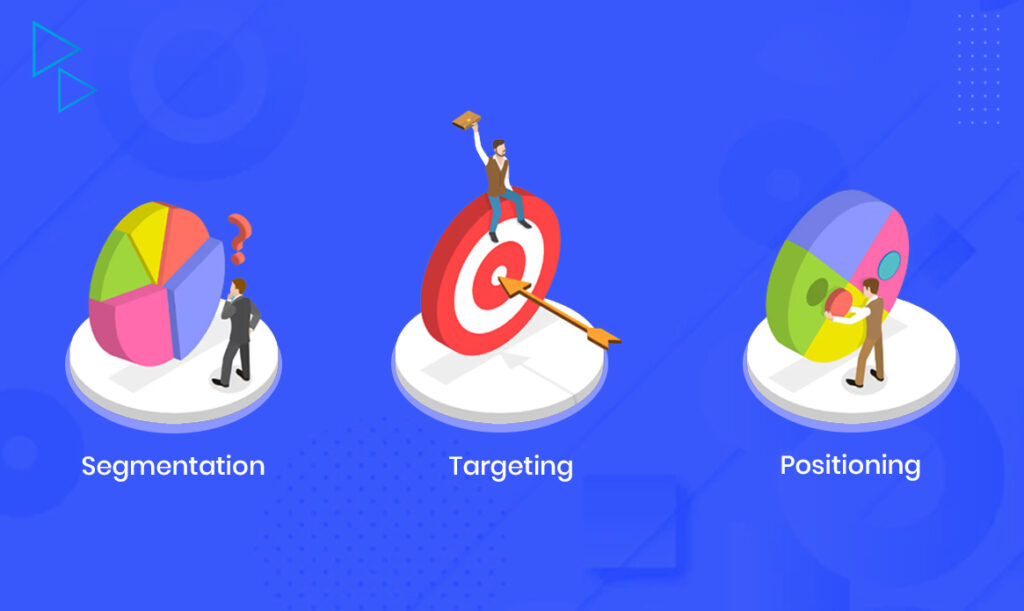Table of Contents
ToggleIntroduction
Gone are the days when the traditional way of just presenting the product was enough to have people buying the product. The options were limited, and so was the audience reach. Today, the world is different, the audience is wiser, and competition is fierce. An effective strategy like Segmentation Targeting and Positioning, or the STP marketing, is a fundamental marketing framework that helps businesses identify the right audience, craft tailored messages, and position the products to attract the most revenue and customer loyalty.ô
What is the Importance of STP Marketing?
Segmentation Targeting and Positioning is a means to transform your marketing campaigns into highly targeted and impactful campaigns. The need arises because you cannot try everything on everyone. More often than not, businesses make the mistake of positioning their product as the ãperfectã fit for everyone. The logic being: if more people know about it, we can reel in more consumers. However, this approach becomes a burden to companyãs resources, messes up the budgets, stresses the employees (as they are spread to thin chasing all customer segments), and leads to brand dilution.ô
Think of it this way: you might be just selling a moisturizer but it has to stand out from the existing moisturizers so that the customer reaches for it on the shelf first.
What is Segmentation Targeting and Positioning?

Segmentation Targeting and Positioning STP marketing model defines whom to market your products to and how to market it by communicating with the ideal customer. By making the marketing communications more focused, relevant, and personalized to resonate with specific groups, builds strong brand connections and ultimately improves conversions and sales. There are three components, or key stages to an STP marketing model
- Segmentation
- Targeting
- Positioning
Letãs break them down one by one with simple explanations and how is Segmentation Targeting and Positioning are dependent on each other.ô
Segmentation: Dividing the Market
Market segmentation is the simple process of dividing all of your audience into smaller, precise, and manageable groups based on common characteristics. The specific segmentation attributes give you better clarity on customer needs, preferences, and choices.ô
Types of Segmentation Based on Unique Needs and Preferences

- Demographic (What): Age, gender, income, education level, occupation, marital status, family size, etc. For example, an apparel brands will target teenagers, young office goers and seniors with different offers.ô
- Geographic (Where): Location, climate, urban, rural, region, state, city, etc. For example, a same ready-to-cook meal can be spicy for Indian customers but mild in taste in European regions.ô
- Psychographic (Who): lifestyle, values, interests, attitudes, personality traits, etc. For example, fitness companies will segment customers based on yoga, body building, or home workout preferences.
- Behavioral (How): Purchase history, brand loyalty, usage rate, website activity, interactions with other campaigns. For example, an e-commerce company will target loyal customers with discounts on their next purchase.ô
- Firmographic (B2B): Company size, industry, revenue, location, employee number.ô
Why is Segmentation Important in STP Marketing?

- Directs resources effectively to focus on those who are likely to be interested in your product or services
- Helps personalize marketing strategies
- Refine and write targeted messages that boost customer engagement by addressing specific needs
Targeting: Choosing the Right Market Segment
Targeting is deciding which segment to focus the marketing efforts on by evaluating and selecting the most profitable and relevant audience. Which segments are worth pursuing based on different factors such as:
- Market size: Is your segment large enough for significant traffic and be profitable?
- Growth Potential: Will the segment grow and expand with time to scale?
- Competition: How tough is the competition in the segment? How many other companies are targeting the same segment with the same product?
- Alignment with Business Goals: Does the segment match the companyãs vision?
- Accessibility: Is the segment easily accessible with the sales and marketing team? Are there any costly barriers in targeting this segment, such as technical or legal compliance issues?
- Difference in Two Segments: Two segments should be different from each other with marked differences.ô
Types of Targeting Strategies in STP

- Mass Marketing or Undifferentiated Targeting: A single approach for the entire market.
- Segmented Marketing or Differentiated Targeting: Different customer groups will need a customized approach.ô
- Niche Marketing or Concentrated Targeting: Focuses on small and specific audiences with unique needs.
- One-to-One Marketing or Micro-Targeting: Hyper-personalized for individual customers based on past behavior or interactions.ô
Businesses can choose to target just one segment or target multiple segments with different marketing strategies based on available resources and capabilities.
Why is Targeting Important?
Knowing which audience to target in segments allows companies to prioritize their efforts and maximize their ROI. It is important that before making the decision, the business has the visibility of all segments in one place and comparing the pros and cons for targeting some segments over others.
Positioning: What makes your Brand Special?
Positioning in Segmentation Targeting and Positioning (STP) marketing is creating and defining the brandãs identity in the consumerãs mind. This has to be a unique and compelling image answering the crucial question: what will make the customer chose your product over competitors?
Positioning is the last stage of Segmentation Targeting and Positioning and requires profound understanding of the needs, wants, and perceptions of the audience before deciding how to communicate with them in the chosen segments.ô
Positioning brings the product to the audience. This stage of Segmentation Targeting and Positioning (STP) marketing requires competitor analysis, figuring out the value proposition, and crafting an impactful message to resonate with the audience segments.ô
| Positioning Strategy | Description | Example |
| Price-Based | Competing on affordability | Flipkart- Walmart (Low Prices) |
| Quality-Based | Focusing on premium quality | Rolex (Luxury Watches) |
| Innovation-Based | Highlighting cutting-edge features | Tata and Mahindra (Electric Cars) |
| User Experience | Providing a seamless experience | Apple (User-Friendly Devices) with high security and longevity |
| Niche Market | Targeting a specific segment | Cult Sport (Athletic Wear for Yoga Enthusiasts) |
Positioning Strategies also Include
- Functional Positioning: Highlighting the practical benefits of the product or service. Involves positioning your brands as a solution to customer pain points.ô
- Symbolic positioning: This positioning focuses on the status that comes with owning the product. This focus is on psychological and emotional benefits of the service or brand, such as prestige, social belonging, exclusivity, etc.ô
- Experimental Positioning: Answers: What do people feel when they use the product or service? Capitalizes on sensory and emotional experiences and the feelings, such as adventure, relaxation, or excitement, they generate.ô
Why is Positioning Important?
Positioning should be consistent across all social media channels that your brand uses to create a lasting and positive experience. It helps convey the USP and puts your brand across as the best for the consumer segmentãs needs. Good positioning encourages trust and loyalty and enhances brand recall.ô
Steps for Implementing Effective Positioningô
- Identify the unique selling proposition; for example, Mahindraãs electric vehicle USP is high-performance electric vehicles with innovative technology and features.
- ô
- Analyze competitors before positioning yourself; for example, Blinkit advertises itself as fresh and convenient.
- Define and highlight the brandãs value proposition; for example, Appleãs phones are promoted as innovative, strong, and user-friendly.ô
- Work on effective messaging and branding, such as slogans, catch phrases, visuals, and campaigns; for example, Amulãs Taste of India slogan has become a benchmark for other products.ô
Segmentation Targeting and Positioning (STP) Marketing Formula

Segmentation Targeting and Positioning are not just isolated steps; they work together:
Segmentation + Targeting = Positioning
Variation in one will affect the other.
An example
Suppose your product is bamboo yoga wear. Not all of the 800-crore people in the world will have a need for it. Your yoga wear to should stand out from other existing brands is the only way to bring in sales. The prime segment for the brand becomes the group of people who understand the value of sustainability and are health conscious. The targetãs needs align with the sustainability and ethical practices of your brand, so you can go ahead and pitch to them. You can position your product as breathable, sustainable, long-lasting, and value for money in the fitness segment, and add in particular USPs for visibility, such as moisture-wicking, durability, and flexibility.ô
Final Thoughtsô
The Segmentation Targeting and Positioning, or STP marketing model, is a powerful tool for businesses, which has a scientific approach and is tried and tested with many powerful enterprises. It increases sales, personalizes marketing communications, gives deep insights into audience behavior, and establishes a strong, long-lasting market presence.ô
Read Also: Leveraging the Benefits of Artificial Intelligence in Marketing Automation
Written By – Amit Bhateja
Amit Bhateja is the co-founder of enrcloud and helping brands and Unicorns from the last 15+ years and overachieve their Engagement and Retention goals. He is passionate about solving customer problems with modern technology, new age solutions, and consultancy approach. Besides Building ENR, He enjoys reading books, spending time with his family and Teammates, traveling, meeting new people, learning new things, and love to close the business deals.





